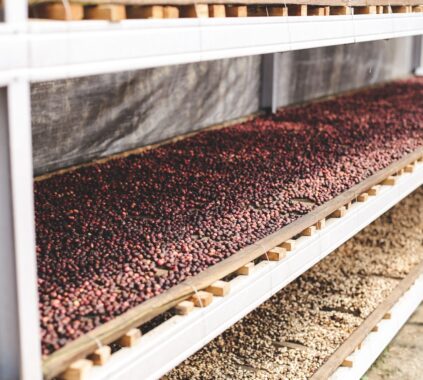Table of Contents
Flavor Profiles of Coffee
Coffee, a cherished beverage consumed by millions worldwide, has a rich history dating back to the 15th century. Its enticing aroma, bold flavors, and energizing effects have captured the hearts and taste buds of countless enthusiasts. In this blog post, we will delve into the complex flavor profiles of coffee, exploring how bean origins, processing methods, roasting, brewing techniques, and even food pairings can influence your coffee experience.

Coffee Beans and Their Origins
There are two primary types of coffee beans: Arabica and Robusta. Arabica beans, known for their delicate, nuanced flavors, account for about 60% of global coffee production, while Robusta beans, with their higher caffeine content and more assertive flavors, make up the remaining 40%. The geographical region in which coffee beans are grown has a significant impact on their flavor profile: Latin America: Known for producing bright, acidic, and fruity coffees with notes of chocolate and nuts. Africa: Renowned for its fruity, floral, and wine-like coffees with bright acidity and complex flavors. Asia-Pacific: Beans from this region are often earthy, spicy, and low in acidity, with full-bodied and bold flavors.
Coffee Processing Methods
Coffee beans are typically processed using one of three methods, which influence their flavor profiles: A. Natural/Dry process: Beans are sun-dried with the fruit still intact, resulting in fruity, wine-like, and complex flavors. B. Washed/Wet process: Beans are depulped and washed, yielding clean, bright, and acidic flavors. C. Honey/Pulped Natural process: A hybrid of the first two methods, where some fruit is left on the beans as they dry, producing sweet, fruity, and balanced flavors.

Coffee Roasting
Roasting transforms green coffee beans into the aromatic and flavorful beans we know and love. Roast levels can be categorized as follows: Light roast: Light-bodied, bright acidity, and complex flavors, retaining most of the bean’s original characteristics. Medium roast: Balanced body and acidity, with a blend of the bean’s inherent flavors and those developed during roasting. Dark roast: Full-bodied, low acidity, and bold, smoky flavors, often with dominant roasty notes. Roast masters must carefully balance the roast level with the bean’s origin and processing method to create the desired flavor profile.
Check out our Coffee Roasting Guide!
The SCAA Coffee Taster’s Flavor Wheel
The Specialty Coffee Association (SCAA) created the Coffee Taster’s Flavor Wheel to help coffee professionals and enthusiasts identify and articulate flavor profiles. The wheel includes key flavor categories like fruity, floral, spicy, nutty/cocoa, sweet, sour/fermented, green/vegetative, roasted, and others. Using the wheel can enhance your understanding and appreciation of coffee’s diverse flavors.
Coffee Brewing Techniques and Their Impact on Flavor
Different brewing methods can accentuate or mute certain flavor profiles: A. Pour-over (e.g., Chemex, V60): Yields a clean, bright, and nuanced cup, showcasing the bean’s inherent flavors. B. Immersion (e.g., French press, AeroPress): Produces a full-bodied, rich, and bold cup, with a heavier mouthfeel. C. Espresso: Creates a concentrated, intense, and complex shot with a balanced blend of flavors. D. Cold brew: Offers a smooth, low-acid, and subtly sweet cup, highlighting chocolate and caramel notes.

Developing Your Coffee Palate
Cultivating your coffee palate involves mindful tasting, attending coffee cuppings, and experimenting with food pairings: A. The importance of mindful tasting: Pay attention to the aroma, flavor, acidity, body, and aftertaste of your coffee. Take your time and savor each sip, noting any unique characteristics. B. Conducting a coffee cupping: A cupping is a structured coffee tasting that allows you to compare and contrast different beans, roast levels, and brewing methods. Participating in cuppings will help refine your palate and expand your coffee knowledge. C. Pairing coffee with food to enhance flavor profiles: Just as wine pairings can elevate a meal, coffee pairings can also bring out the best in both your coffee and your food. For example, a bright, fruity coffee might pair well with a lemony dessert, while a dark roast could complement a rich, chocolatey treat. D. Expanding your coffee horizons: Be adventurous and try new beans, origins, roasts, and brewing methods. This exploration will help you discover new flavors and develop a deeper appreciation for coffee.
The diverse world of coffee offers endless opportunities to explore and enjoy its vast array of flavors. Embrace this journey by experimenting with different beans, roasts, brewing techniques, and even food pairings. As you continue to develop your palate, you’ll gain a deeper appreciation for the complexities of coffee and the countless ways it can delight your taste buds.
Daily Demitasse is a participant in the Amazon Services LLC Associates Program, an affiliate advertising program designed to provide a means for sites to earn advertising fees by advertising and linking to Amazon.com. We also participate in other affiliate programs which compensate us for referring traffic.














